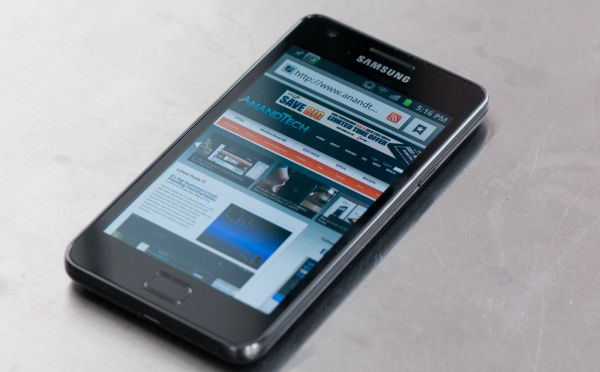Samsung Galaxy S 2 (International) Review - The Best, Redefined
by Brian Klug & Anand Lal Shimpi on September 11, 2011 11:06 AM EST- Posted in
- Smartphones
- Samsung
- Galaxy S II
- Exynos
- Mobile
Display
One of the highlights of SGS2 is its 4.3“ SAMOLED+ display, which we’ve seen before on phones like the Droid Charge, and a 4.5” version of on the Samsung Infuse 4G. Though the panel is the same as what we’ve seen in the past, the controller and software are different.
As a quick refresher, Samsung has now passed through three variants of AMOLED. The first was straight up AMOLED which we saw on phones like the Nexus One and Incredible in a 3.7“ WVGA format with RGBG PenTile. The next was Super AMOLED, which was 4.0” WVGA with PenTile and adorned Galaxy S. The main improvements with Super were integration of the digitizer with top glass and use of optically transparent adhesive to reduce air gaps and subsequent fresnel reflections that add glare and reduce transmissivity. The net effect of that was improved outdoor readability and potentially some power savings from losing less light to back reflections.


Left: Super AMOLED Plus, Right: Super AMOLED
So now we’re up to Super AMOLED Plus (SAMOLED+), so what does this add? Well first, size is now 4.3“ or 4.5” (depending on what tickled some carrier’s fancy), and resolution is still WVGA (800x480), but the big change is that PenTile RGBG is gone. In its place is a standard RGB stripe. I’ve been rather critical of RGBG PenTile in the past purely because it emulated higher effective resolutions by using fewer subpixels (2 per logical pixel) and as a result had a characteristic grain in some circumstances. On AMOLED especially it wound up being distracting more than it was novel, and on 4" displays, it seemed that subpixels were visible with the naked eye and average visual acuity. Furthermore there were some issues with an offset pattern like RGBG and the UI direction Android was taking. Single pixel wide UI elements, some text, and solid primary colors were the main culprits where RGBG could, without considerable scrutiny, look characteristically grainy.
So why is it gone now? The big reason is probably because a corresponding move to a larger panel increases the size of those subpixels, and no doubt 4.3“ WVGA with PenTile would look even more grainy despite having the same ”effective“ resolution. Four inches was pushing it for a grid that started life at 3.7”, and 4.3“ probably was a step too far. In addition, subpixels are also correspondingly larger in the 4.3” RGB stripe (and the process mature enough now) that certain color subpixels being more prone to failure than others (and this needing to be sized appropriately) should no longer be a concern. Samsung also claims that power drain has been reduced in SAMOLED+ by almost 20% from the previous generation, no doubt partially thanks to fabrication maturity and changes made that come with better understanding of the process.
The same benefits apply with SAMOLED+ as the previous generations though - absolutely black blacks due to the subpixels not emitting any light in the off state, and potentially super vibrant colors (if calibrated properly). Unfortunately the few issues we saw with SAMOLED+ on other phones continues here as well - white point that varies with brightness level, a chance of overheating, and a bit of lingering sharpening.
Let’s start with the first one, which a lot of users have dubbed ‘yellowing’. For a while now we’ve been gathering white point data at various brightness levels. Obviously we did the same thing with SGS2.

I’ve measured brightness (full-screen white and black) and white point at six brightness levels on the SGS2. Before I measured the SGS2, I noted that subjectively there’s the most visible change in color temperature after you dip below the 50% brightness mark. To that extent, I took more measurements below that halfway point. I also tossed in the Samsung Infuse 4G (which we received but didn’t formally review) which has a 4.5" SAMOLED+ display that no doubt is identical to what’s headed to the Sprint and T-Mobile SGS2 variants, though with a different display controller. I also tossed in the Samsung Galaxy S 4G as a SAMOLED data point, and the Nexus One as an AMOLED data point, just so you can see how things have changed over the now 3 generations of AMOLED panels Samsung has shipped.
The data bears out the effect that numerous subjective parties have noticed - SGS2’s display temperature gets warmer at lower brightnesses, and varies between 7328K at 0% brightness and 8600K at 100% brightness. It’s enough of a delta in white point to be unfortunately very visible to the naked eye. There’s also an interestingly large amount of variance between the three SAMOLED+ phones we’ve measured, though the same shape curve is just translated around for the Infuse, the Charge appears to be very blue everywhere. Bear in mind again that the SGS2 uses a different display controller than the previous generation of devices.











132 Comments
View All Comments
ph00ny - Sunday, September 11, 2011 - link
Btw you can launch search by holding down the menu buttonAloonatic - Sunday, September 11, 2011 - link
Just curious, but have MS given up on the smartphone market? Or have I just missed out on all the new (or soon to be release) WP7 devices?At this rate, I'm just going to have to go with Android and a SGS II, even though I'd love a WP7 phone, but what there is out there are just all old handsets, and I'd have to change carrier to get one now too, as T-Mobile (UK) don't seem to sell them at all any more!?!?!?111!
dagamer34 - Sunday, September 11, 2011 - link
If I had to guess, OEMs are working on their new handsets, but want to load them with Windows Phone 7.5, which only RTMed officially a few weeks ago.My best guess is we'll see some more phones around October or so, with a Galaxy S II shaped WP7 device.
Aloonatic - Sunday, September 11, 2011 - link
Well, October is what I figured too, but... We're already over a week into September and there still aren't any "coming soon" 7.5 devices to be seen anywhere, so I'd be surprised if October (as in the start of October) is anything but wishful thinking.It starting to seem like MS just aren't that bothered. Where's the "ooh, look at this coming soon phone" stuff? The SGS 2 like WP7 phone has been mentioned all over the web for months, but there's nothing remotely official, and with only the odd photo shopped image from net dreamers.
It's a shame, as I'm not a fan of Apple, their products or how they behave. And I've tried Android and been annoyed by their poor updating system, where too many companies have been allowed to let year old hardware languish at the back of the update queue (if it's lucky) while the new devices get all the attention and you're left with juddering menus and in some cases shocking security holes.
Maybe it's just me, and my problem, for hoping that WP7 might offer a solution to my woes, but MS are just leaving this all waaaaaaayyyyy too late. By the time they get to the party someone will be handing them a bin bag and asking them to help clear up.
ph00ny - Sunday, September 11, 2011 - link
What do you mean? It was in the video presentation for the mango announcement month or two agohttp://www.youtube.com/watch?v=ABO_LyD_SXs
right around :40 he whips it out of the pocket. I guess he couldn't wait to use it as his daily phone
Aloonatic - Sunday, September 11, 2011 - link
Oh, so they have a few units the they showed on a video presentation that who saw exactly?Yes, I may have been exaggerating slightly before (and I know that that doesn't stand on geek boards) and we've all (well, a reasonable percentage, as I am sure that at least 1 person reading this hasn't) seen the "leaked" video that no one *wink wink* should video and get out.... But really, there's nothing to be seen here. Those videos are no more proof of a finished product than a concept car at a motor show.
I'm just disappointed that they hare dragging their feet on this product, and really don't seem to care either.
ph00ny - Sunday, September 11, 2011 - link
This was posted on a lot of major tech blog/news sites. As for devices, there are quite a few announced devices but they're all waiting for the mango updatevision33r - Monday, September 12, 2011 - link
Samsung phones are outdated in one quarter. They release small updated features to the same platform.The Galaxy line had 4-5 different variant versions within the same year.
This makes update very difficult for them and also buyer confusion.
I'll stick with HTC, since Samsung takes forever to fix software and issue timely updates.
ph00ny - Monday, September 12, 2011 - link
which device outside of the US carrier branded ones didn't get updates as soon as HTC devices? In fact, which android device manufacturer doesn't release 4-5 different variants within the same year?aegisofrime - Sunday, September 11, 2011 - link
Had mine here in Singapore for about 3 months now, and you Americans will be joining the party with plenty of custom ROMs and kernels to choose from :)So yeah, welcome to the party!
This forum will probably be your new best friend now:
http://forum.xda-developers.com/forumdisplay.php?f...
(Galaxy S II Original Android Development)